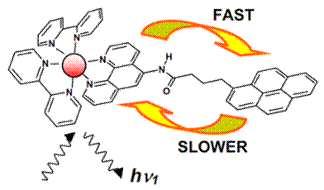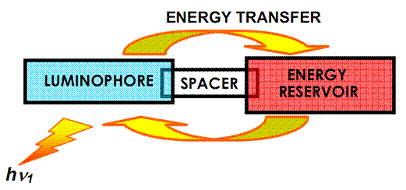|
Facilities |
|
Molecular Photodynamics and Electronics Photonics&Materials Group |

|
REVERSIBLE ENERGY TRANSFER IN SUPRAMOLECULAR SYSTEMS
The management of energy following light absorption is of fundamental importance for the development of efficient optoelectronic devices, charge separation and ultimately energy storage (as chemical energy). This is exemplified in natural photosynthetic systems where a structurally complex multiporphyrin architecture can absorb light energy before subsequently transferring it in a unidirectional fashion to drive a charge transfer process at a distant site, ultimately transforming light energy into chemical energy, via multi-electron processes.
Recent research efforts in the direction of artificial photosynthesis are largely directed at developing multichromophoric antenna systems which efficiently absorb light energy and transfer it in a unidirectional fashion to a specific site following a downhill energy gradient. Close to 100% efficiency in energy transfer can now be routinely obtained. In terms of temporary energy storage, it was recently shown that in multicomponent molecule-based systems, reversible energy processes can be used to temporarily store electronic excitation energy at one site in multicomponent supramolecular systems, before efficiently funnelling the energy back to a specific (emissive) site.
Major goals of our research are to employ this reversible energy transfer process in multicomponent systems for the purpose of charge separation; to improve the photophysical properties of a diversity of molecules such as light harvesting pigments and fullerenes, as well as to study reversible energy transfer between a photoactive guest molecule and a photoactive nanostructured support matrix, as an approach to ultrasensitve sensing devices.
Copyright 2020 © Gediminas Jonusauskas, Laboratoire Ondes et Matière d’Aquitaine - UMR 5798 CNRS/Université Bordeaux |

